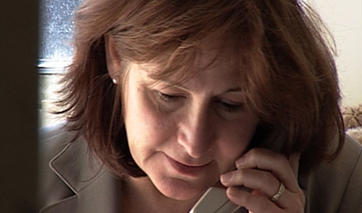PARTICIPANTS
Esther Olavarría
At first, it seemed like we‘d never even get in to meet Esther, Senator Kennedy‘s famous Immigration Counsel. In a few short weeks in Washington, we‘d learned that she was central to everything going on with the subject we wanted to follow. But the Kennedy office, especially the Judiciary Committee outpost in the Dirksen Building, was so busy, especially after 9/11, that our film idea hardly sounded like the first order of business. To her, or really to us either.
Finally in the late fall, we had a chance to plead our case. She was super-busy, as advertised, and reasonably polite, but seemed far from overcome by the glamour of being in our movie. It took another 4 or 5 months for her to arrange for us to meet Senator Kennedy for the real permission. But once we did meet him, and he said, “Okay, I‘ll help you do this,” everything changed with Esther.
From the minute we walked out of the Senator‘s office together, she started teaching us, showing us, filling in backstories, making introductions to all sorts of impossible people we‘d never have met any other way, and most fantastically of all, just being her perfectly natural self with us, whether there was a camera in her face-- or lap-- or not. Esther transformed, almost instantly, into our essential star. And we could not have been luckier.
Plenty of people have felt lucky to meet or work with Esther. Her long-time deputy, Janice Kaguyutan, has a funny story about meeting Senator Kennedy for her own job interview and raving on about her excitement over the opportunity to work with Esther!
Before joining Senator Kennedy‘s staff, Esther had worked for years as an attorney for immigrants and refugees in Miami. She and her family were refugees, who left Cuba when she was a child. Esther practiced at the Haitian Refugee Center and at Legal Services of Greater Miami before co-founding the Florida Immigrant Advocacy Center.
But when Congress passed a set of laws which were particularly harsh toward immigrant families in 1996, Esther decided the best way to help a great number of people would be to help change the law. So she came to Capitol Hill, to “Fix ‘96”, as the campaign slogan said.

In Senator Kennedy‘s office, the obvious part of her job was to write immigration legislation, whether it focused on a small matter or something as big as comprehensive reform; the less evident corollary to writing bills was her work at the staff level to find the support for whatever deal would be necessary for a given bill to pass. That process, and Esther‘s amazing resilience in pursuing it over and over through the gauntlet of setbacks that challenged the comprehensive immigration reform bill we came to DC to follow in 2001, is the central story of How Democracy Works Now.
The series ends before Esther, and the process she wrangled, reach the goal. But the process does not end there. Esther is still writing immigration language, and still working toward that elusive, comprehensive reform. Only now, she‘s doing it as Deputy Assistant Secretary for Policy at the U.S. Department of Homeland Security.



















































